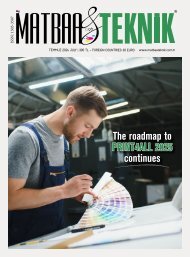You also want an ePaper? Increase the reach of your titles
YUMPU automatically turns print PDFs into web optimized ePapers that Google loves.
67<br />
Two almost identical<br />
Monforts<br />
sanforizing lines<br />
now provide<br />
Wülfing with<br />
much improved<br />
flexibility.<br />
All told, the company has over 500 employees and with<br />
160 weaving machines in continuous operation has an annual<br />
capacity of 60 million square metres of cotton fabrics<br />
– roughly the area of 8,400 football pitches. In addition<br />
200,000kg of high quality 95% cotton yarns are always<br />
in stock, with 15,000kg processed into fabrics on a daily<br />
basis.<br />
“Our particular strength is in wide-width weaving and the<br />
development of customer-specific ranges,” says Gerd<br />
Schulte-Mesum, Wülfing’s Borken plant manager. “We<br />
have fully-integrated production in Germany on the most<br />
modern machines and flexibility is fundamental to our<br />
continued success. The fast-moving market demands ever-increasing<br />
innovation, service and the rapid implementation<br />
of new ideas.”<br />
Fabric stability<br />
At its Borken plant, Wülfing has employed a Monforts<br />
sanforizing line since 2009 to guarantee the required dimensional<br />
stability and shrink-fastness of its high quality<br />
bed linen. With a working width of over three metres, the<br />
sanforizing process is a central pillar in the production of<br />
typical wide-width cotton fabrics for home textiles.<br />
In 2017, the company was able to acquire a second<br />
Monforts sanforizing line from another company which,<br />
although built in 2005, had been virtually unused. It was<br />
overhauled and installed behind a Monforts equalizing<br />
frame of a similar age.<br />
“Unfortunately, the two machines had to be operated<br />
separately via individual controls and did not represent<br />
an integrated unit,” says Schulte-Mesum. “This resulted<br />
in deficits in the desired productivity and in the control<br />
technology.”<br />
Wülfing consulted with Monforts on a number of upgrade<br />
options and opted for a completely new joint control system<br />
to merge the two machines, as well as a new connecting<br />
inlet, a tensioning and damping field and a steaming<br />
unit.<br />
“Monforts provided a fast and precise erection and commissioning<br />
of the technology in spite of the difficult pandemic<br />
circumstances,” says Schulte-Mesum. “The result<br />
has been an increase in production speeds by 20% and<br />
enhanced uniformity in fabric width through a much improved<br />
guidance system.<br />
“We are also achieving energy savings as a result of the<br />
new control and drive technology and operation has been<br />
simplified and improved as a result of the unified control.<br />
We benefit from simplified access for maintenance work<br />
such as the grinding of the rubber blanket, but most of all<br />
we have greatly improved our flexibility and now have two<br />
almost identical Monforts sanforizing lines.”<br />
“It’s been a pleasure to work with the team at Wülfing on<br />
this project, which demonstrates what is possible in the<br />
modification and upgrading of Monforts machines already<br />
in operation,” adds Thomas Päffgen, Monforts Area Sales<br />
Manager.

















